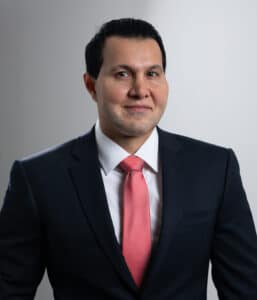Rotator Cuff
Home » Personal Injury Resources » Types of Injuries » Rotator Cuff

The rotator cuff is exactly what it sounds like. This group of muscles surrounds or cuffs the arm bone where it meets your shoulder. There, the muscles hold the joint together so you can rotate, lift, and extend your arm without dislocating your shoulder.
When you injure your rotator cuff, you could experience severe disabilities. While you recover, doctors will likely immobilize your arm, leaving you unable to use it to lift, carry, drive, write, or type. Worse yet, you may require expensive surgery and physical therapy to repair your shoulder.
Table of Contents
What Is the Anatomy of Your Shoulder?

Your arm meets your thorax at your shoulder. More specifically, the humerus of the arm includes a ball that fits into a socket in your scapula. But the socket of the scapula is different from the socket in your pelvis because it does not completely surround the ball.
Instead, the socket of your scapula only meets the head of your humerus so that the ball rests against the cup-shaped socket. This gives the arm a smooth pivot point. But the bones provide only minimal security from dislocation.
Instead, your shoulder is held together by the rotator cuff.
This group of four muscles includes:
- Supraspinatus: Attaches the back of the scapula to the top of the humerus to lift the arm
- Infraspinatus: Attaches the back of the scapula to the back of the humerus to rotate your arm
- Teres Minor: Sits below the infraspinatus and assists it in rotating your arm
- Subscapularis: Connects the front of the scapula to the front of the humerus to extend your arm forward
These muscles cooperate with the biceps and triceps to move your arm and give it strength. Altogether, your shoulder has several bones, including the humerus, clavicle, and scapula, and many ligaments, muscles, and tendons to help it operate smoothly.
What Causes Rotator Cuff Injuries?
You can injure your rotator cuff in many ways, including:
Hyperextension
A powerful force pulling on your arm can hyperextend the muscles of the rotator cuff. As they stretch, these muscles develop tears. With enough force, the muscles can tear completely.
Hyperextension injuries can happen in workplace accidents. For example, if something falls and you try to catch it, you can hyperextend your rotator cuff. Similarly, you can hyperextend your rotator cuff when you fall and try to catch yourself. Your weight can pull hard enough on your rotator cuff to tear it.
Repetitive Stress
Stresses create minor tearing of your muscles and tendons. When you take the time to heal, you strengthen these soft tissues. But if you repeat the same motions without healing, these tears will propagate and spread.
Repetitive stress usually results from repetitive motions like lifting, throwing, pushing, and pulling. Workers who perform the same motion for hours on end can develop rotator cuff tears. As a result, these injuries can form the basis of workers’ compensation claims.
Blunt Trauma
When you strike your shoulder on something without producing an open wound, you could have a blunt-force injury. Blunt trauma can bruise the muscles that form the rotator cuff. This type of trauma can happen if you hit your shoulder in a fall or car accident.
Penetrating Trauma
Penetrating trauma causes an open wound in your shoulder. For example, you could suffer penetrating trauma when you hit the ground after a motorcycle accident. Debris, such as broken glass, can lacerate your rotator cuff.
What Types of Rotator Cuff Injuries Can Occur?
Rotator cuff injuries can take many forms, including:
Bruises
Blunt trauma can break blood vessels under the skin. These blood vessels create the discoloration characteristic of bruises. You will also experience pain and inflammation in your shoulder due to the damaged tissues. Fortunately, bruises usually heal quickly with no side effects.
Lacerations
Sharp objects can lacerate the soft tissues of the rotator cuff, including skin, muscles, and tendons. This tissue damage can reduce the strength and range of motion of your shoulder.
The laceration can also bleed and become infected. Infections happen when microorganisms invade your body. In response to the infection, your body will trigger fever and swelling. Between the toxins released by the invaders and your body’s response, you will become very sick.
Strains
A strain occurs when the rotator cuff muscles and tendons hyperextend.
They stretch and tear under stress, producing:
- Pain
- Inflammation
- Weakness
- Stiffness
- Muscle spasms
A partial rotator cuff strain may heal on its own with rest and anti-inflammatory medication. If you suffer a total tear of the rotator cuff, the tendon holding one or more of the muscles has separated from the humerus or scapula. These injuries will likely require surgical repair.
In either case, you will probably need physical therapy to build your strength and flexibility after your rotator cuff heals. But even with surgery, rest, and physical therapy, you may never regain your pre-accident abilities.
Tendonitis
Tendonitis, also called tendinopathy, develops when the muscles and tendons become irritated. The damaged cells cause inflammation of the tissues.
These injuries will cause:
- Pain
- Swelling
- Limited range of motion
The pain from tendonitis may feel sharp. However, most people experience nagging aches, particularly after using the shoulder or laying on it at night.
Tendonitis will often heal with rest and anti-inflammatory drugs.
How Can You Recover Compensation for a Rotator Cuff Injury?
You may be entitled to workers’ compensation benefits if you suffered a rotator cuff injury at work. These benefits are paid by your employer’s workers’ comp insurer. You can receive these benefits regardless of how long you worked for your employer or who caused your accident.
These benefits are limited. The insurer will pay 100% of your medical expenses for treating your rotator cuff injury. But you will only receive a portion of your income losses that resulted from your disabled shoulder.
Conversely, if your rotator cuff injury happened away from work, such as in a car accident or slip and fall accident, you may have a personal injury claim against the person or business that caused your accident. To get compensation, you need to prove that the other party failed to exercise reasonable care and that you hurt your rotator cuff due to that failure.
If you can prove negligence, you can recover compensation for your financial losses and the diminishment in your quality of life. To discuss the damages you may recover for your rotator cuff injury, contact the experts at M&Y Personal Injury Lawyers by calling 866-864-5477 for a free consultation.
